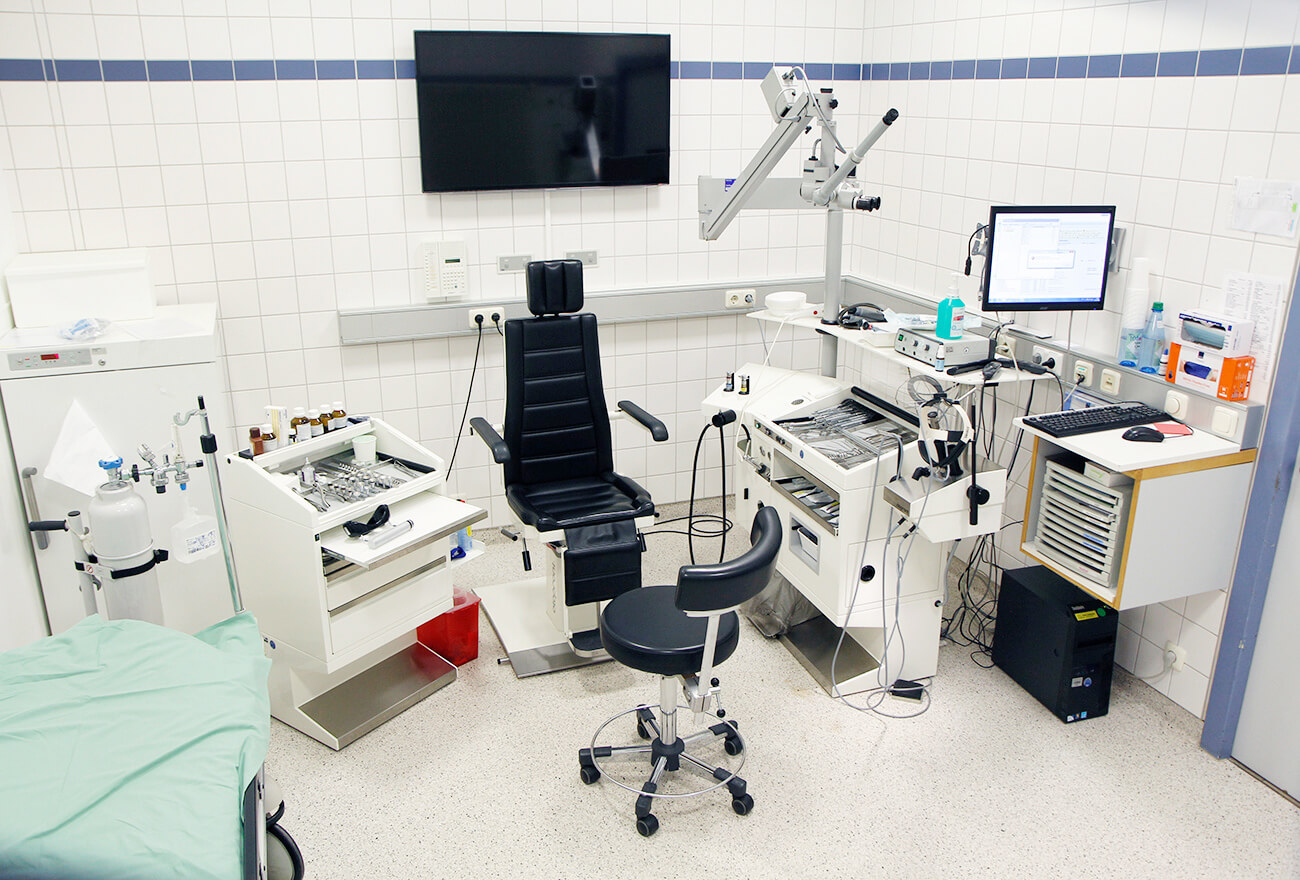Middle ear surgery
In the ENT Clinic at the Klinikum rechts der Isar, all common ear operations are performed. On the following pages we will inform you about how our hearing works, hearing disorders in general and individual ear operations. If you have already been diagnosed with an ear disease that requires surgical treatment, we would be happy to arrange an appointment for a presentation.
Ear surgery
Almost all ear operations can be performed under general or local anesthesia. For reasons of comfort, the majority of our patients today choose general anesthesia. Usually a stay of three to four days is necessary.
The middle ear is accessed either through the ear canal (endaural) or through an incision behind the ear (retroauricular). In this way, the surgeon can reach behind the eardrum, under the skin of the auditory canal, and thus the middle ear. The sutures required for suturing are removed after one week (this can also be done by the patient's family doctor or a registered ENT specialist if desired). In middle ear surgery, a tamponade of fine gel sponges is usually inserted into the ear canal to allow the eardrum to heal safely. Such a tamponade is usually removed two to three weeks after the procedure in a control examination.
One of the main goals of ear surgery is to clear the ear of areas of inflammation or - in rare cases - tumors. Another important reason for surgery is to improve hearing. Most ear surgeries can be described as tympanoplasty. The Greek word tympanon means "kettledrum" and is therefore a synonym for the middle ear. The suffix -plasty is used to indicate that a restorative procedure is to be performed. This includes the closure of holes in the eardrum as well as the reconstruction of defects in the ossicular chain. In a broader sense, rehabilitative middle ear surgery for the cholesteatoma (formerly known as "bone ulceration") can also be included. In the case of the cholesteatoma, the primary goal is to rid the ear of the focus of inflammation, because the cholesteatoma (also known as "pearl tumor") is an aggressive ear inflammation which, if left untreated, gradually destroys all bony structures in its surroundings. A cholesteatoma must be surgically removed, i.e. affected bone structures must be ground down with a drill. After an extensive rehabilitative procedure, it may be necessary to reconstruct the hearing ability at the back until the middle ear structures have healed. A second hearing-improving operation is then performed after about one year. Every hearing improving middle ear surgery aims to improve conductive hearing loss by optimizing the transmission of the eardrum and ossicular chain. In order to improve the chain transmission, sometimes the body's own material, e.g. small pieces of cartilage, are inserted so that the chain fits together again. In addition, there are various prostheses (e.g. made of titanium) which can replace the ossicular chain either partially or completely.
Another common middle ear procedure is stapesplasty, where the stapes ossicle is replaced. This operation is considered for the diagnosis of otosclerosis. In the case of otosclerosis, a progressive ossification of the anchoring of the stapes in its connection to the inner ear occurs. The result is initially an increasing conductive hearing loss, in later stages possibly also combined hearing loss. In stapesplasty, a hole is usually drilled in the ossified footplate of the stapes and a stapes prosthesis is inserted there.
Possible complications:
Our surgeons are very familiar with the structures and adjacent structures of the ear. Nevertheless, as with any other procedure, complications can occur during an ear operation. We will explain the risks and their probabilities to you during the preoperative clarification.
Any change in the normal form or function of any part of the hearing aid can lead to a hearing disorder. Roughly speaking, hearing disorders can be divided into conductive and sensory disorders.
Conductive hearing loss
Von einer Schallleitungsstörung spricht man, wenn die mechanische Schallübertragung über den Gehörgang, das Trommelfell und die Gehörknöchelchen zum Innenohr gestört ist. Dies lässt sich einfach mit einem verstopften Gehörgang simulieren. Zum Beispiel kann ein Defekt am Trommelfell oder eine Unterbrechung oder Versteifung der Gehörknöchelchenkette zu einer Schallleitungsstörung führen. Auch ein sogenannter Paukenerguss, eine Flüssigkeitsansammlung im Mittelohr, dämpft die Schallübertragung. Unterschiedliche Erkrankungen können diese Probleme verursachen, darunter akute oder chronische Entzündungen, eine Otosklerose (Steigbügelfixierung), Verletzungen, starke Druckwellen (wie beim Explosionstrauma), angeborene Fehlbildungen von Gehörgang und Gehörknöchelchenkette oder Tumoren des Mittelohres. In vielen Fällen kommt eine Operation zur Behandlung dieser Erkrankungen in Frage. Das Ziel einer ohrchirurgischen Behandlung ist in erster Linie immer die Beseitigung der Pathologie und in zweiter Linie die Wiederherstellung oder Verbesserung des Gehörs, indem eine möglichst ungehinderte Schallleitung rekonstruiert wird. Mitunter kann sich der chirurgische Aufwand, eine normale Schallleitung herzustellen, aber als unverhältnismäßig, zu schwierig oder unmöglich darstellen, wie z.B. bei angeborenem Fehlen von Ohrmuschel, Gehörgang und Mittelohr, oder wie bei vielfachen vorangegangenen erfolglosen Operationen. Dann kann ein Hörimplantat helfen, das alle Schallleitungsstrukturen einfach übergeht und direkt das Innenohr reizt.
Sensorineural hearing loss
If the perception of stimuli in the cochlea or the transmission of stimuli from the auditory nerve to the brain is impaired, a sensorineural hearing loss is present. Disorders of the cochlea, i.e. the inner ear function, include acute sudden deafness or presbyacusis. In addition, a chronic noise hearing loss or toxic disorder (as with some inflammations or due to certain medications) can cause inner ear hearing loss.
The treatment of these conditions is in turn less often surgical. If an inflammation is present, it is of course necessary to remove it. Otherwise, in some acute cases an infusion therapy with e.g. cortisone is a possibility. For chronic diseases, i.e. when the form and function of the hair cells is disturbed, there is currently no recognized therapy to restore hair cell function. The only remaining option is therefore hearing aids. These include the conventional hearing aid, but also hearing implants such as sometimes a middle ear implant or, in cases of severe hearing loss or deafness, a cochlear implant. Sensorineural hearing loss caused by disorders of the auditory nerve or brain is very rare. The most common are benign tumors of the surrounding cells of the auditory nerve, the so-called vestibularis schwannomas or acoustic neuroma. These in turn are to be treated either surgically or by radiotherapy.










